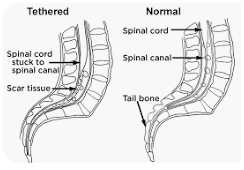TETHERED SPINAL CORD
Intramedullary spinal cord tumours are rare lesions of the central nervous system. They are situated within the spinal cord. One of the common sites for such tumours is the conus (distalmost end of the spinal cord) and the collection of nerves at the end of the spinal cord is known as the cauda equina (due to its resemblance to a horse's tail).
Tethered cord syndrome is a rare neurological condition in which the spinal cord is attached (tethered) to the surrounding tissues of the spine. This prevents the spinal cord from moving to keep up with the lengthening of the spine as it grows. It can cause back pain, numbness in the legs or feet, deformities such as hammertoes, feet turning in or out, incontinence, chronic constipation, and frequent urinary tract infections.
Generally, it is presented in children and late adolescence. There may be lesions on the lower back like a fatty tumour or deep dimples on the lower back, or skin discoloration on the lower back or hairy patch on the lower back
Surgery is the main treatment for a tethered cord. In this procedure, the spinal cord is released from the surrounding spine so that it can move freely. If treated early, any damage resulting from the tethered cord can often be improved.


Visual Representation of tethered vs normal spinal cord


Low lying spinal cord
